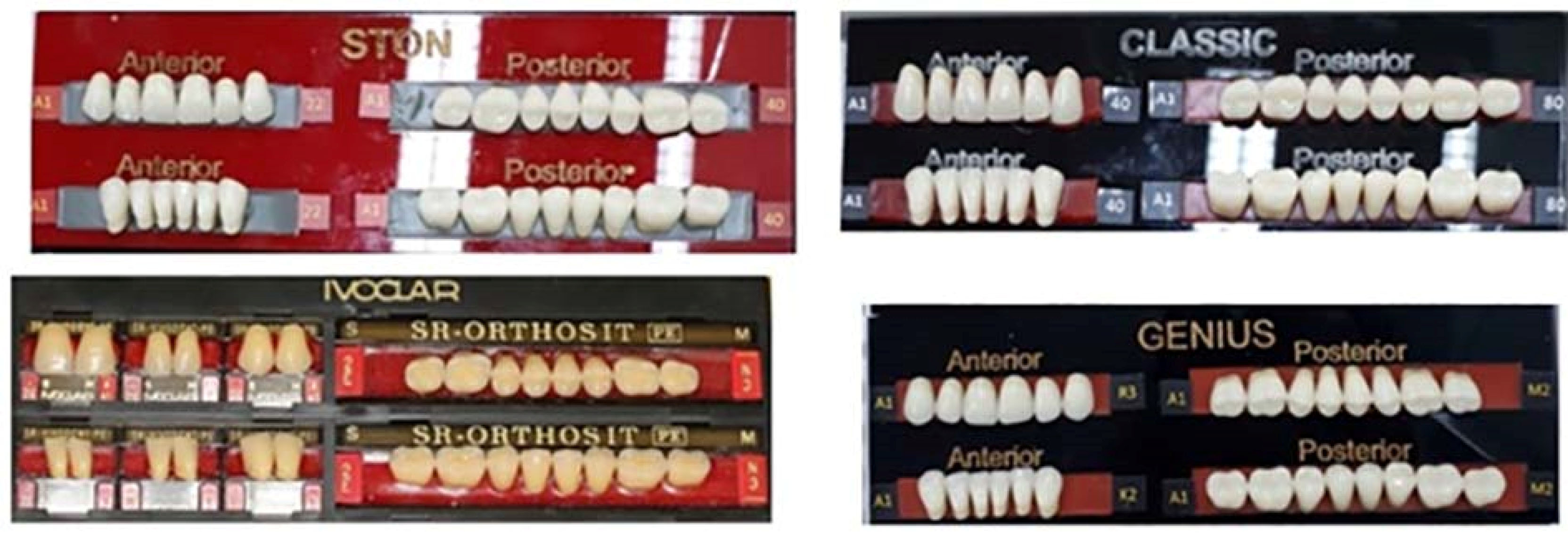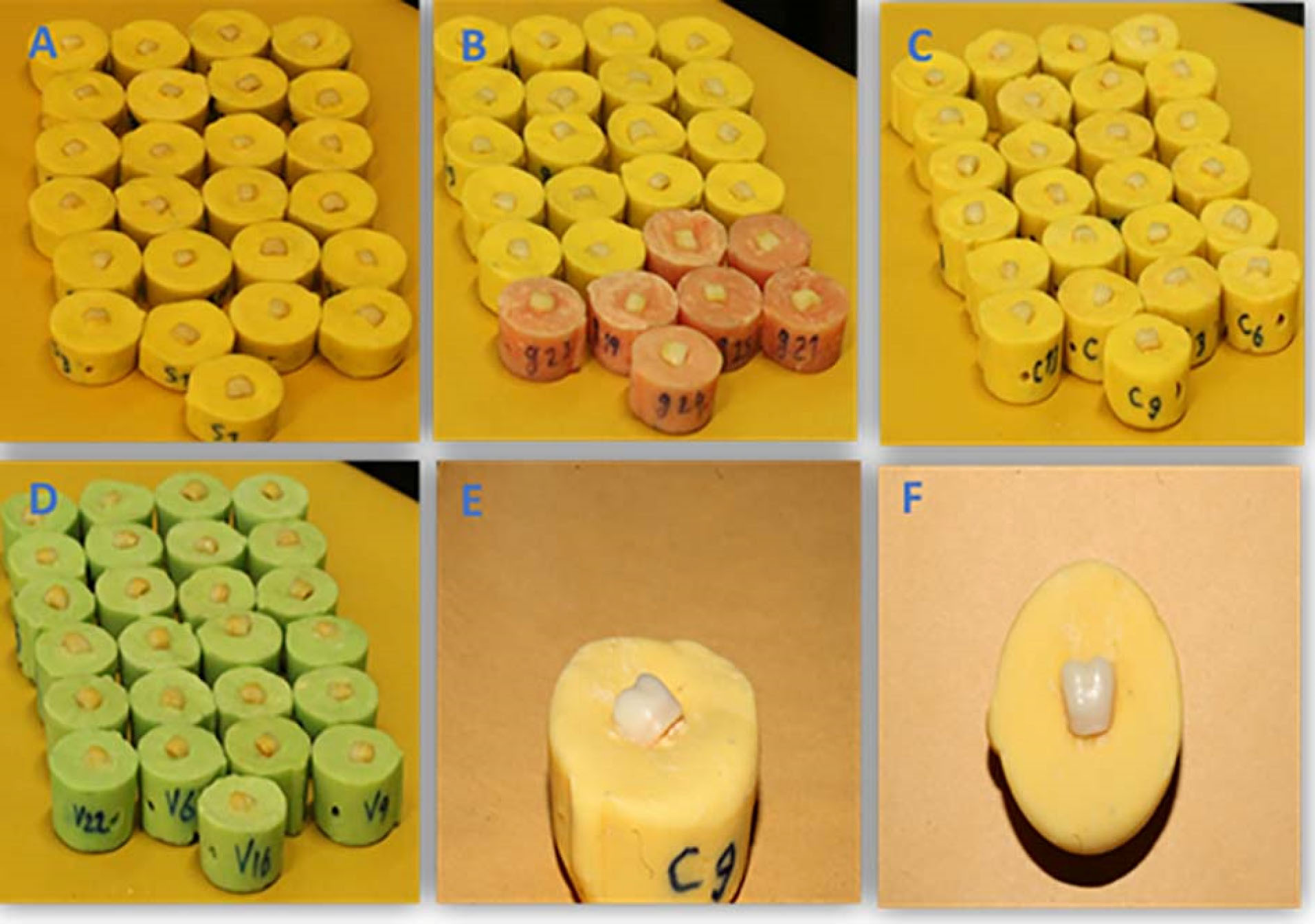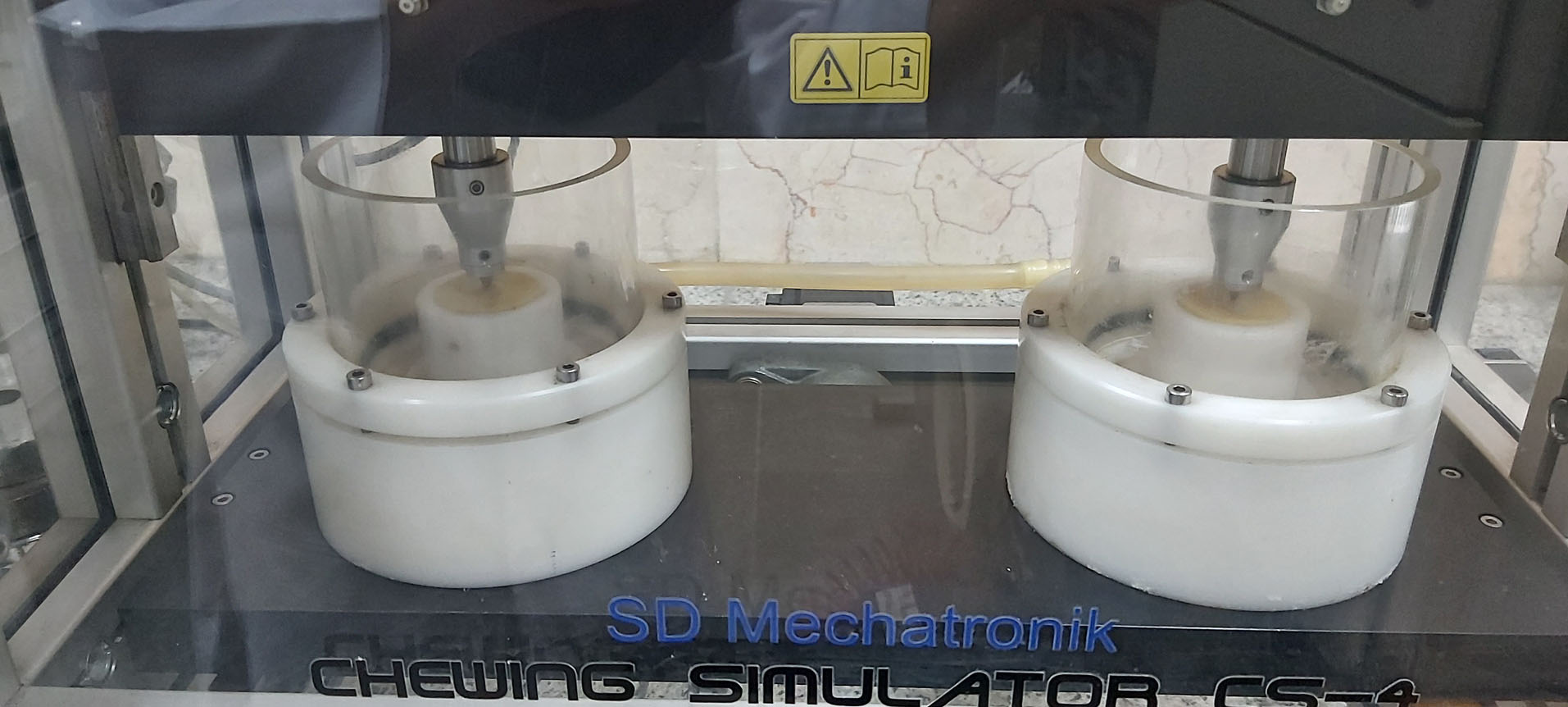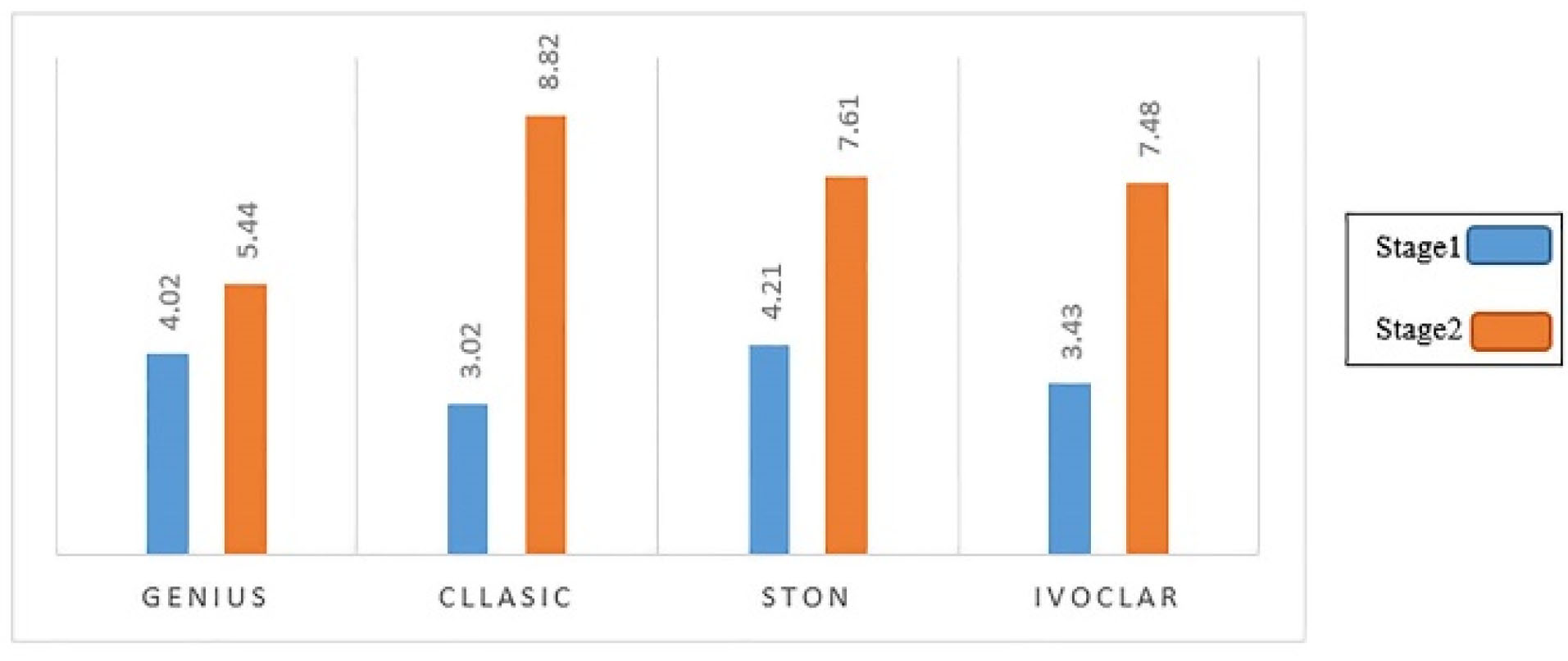Avicenna J Dent Res. 13(2):47-51.
doi: 10.34172/ajdr.2021.09
Original Article
The Effect of Glaze Coating on Wear Resistance of Some Acrylic Denture Teeth: An In Vitro Study
Samaneh Abbasi 1, Soodabe Ebrahimi 2, *  , Arash Shisheian 1, Maryam Farhadian 3
, Arash Shisheian 1, Maryam Farhadian 3
Author information:
1Assistant Professor, Department of Prosthodontics, School of Dentistry, Hamadan University of Medical Sciences, Hamadan, Iran.
2Postgraduate student of prosthodontics, Department of Prosthodontics, School of Dentistry, Hamadan University of Medical Sciences, Hamadan, Iran.
3Associate Professor, Department of Biostatistics, School of public Health Hamadan University of Medical Sciences, Hamadan, Iran.
Abstract
Background: Acrylic resin teeth wear resistance has an important role in the denture longevity. This study aimed to clarify the effect of glaze coating on wear resistance of three types of artificial acrylic teeth.
Methods: In this in vitro study, the wear resistance rate of three of acrylic denture teeth (GENIUS, STON and CLASSIC) was compared with Ivoclar teeth (n=25/group). The wear resistance was measured by estimating the weight loss in pre and post removing glaze coating, following 5000 cycles in the chewing simulator device. Data analysis was made using paired t test, one-way ANOVA and Tukey’s post hoc test.
Results: ANOVA test showed that there was no significant difference between the mean amount of wear of GENIUS, CLASSIC, STON and IVOCLAR teeth in the first stage (P <0.061), but this difference was significant (P <0.001) in the second stage. The result of Tukey post hoc test showed that wear rates of GENIUS were significantly lower than other groups (P<0.001). Comparison between the mean wear rates of each dental group at the first and second stages showed a significant difference between average teeth wear resistance of CLASSIC, STON and IVOCLAR in the first and second stages (P <0.001).
Conclusions: In conclusion, the teeth wear resistance of STON and CLASSIC were similar to IVOCLAR. Also, after removing the glaze coating, the teeth wear resistance decreased in all groups but was not statistically significant for group GENIUS.
Keywords: Denture, Acrylic Resins, Coating
Copyright and License Information
© 2021 The Author(s); Published by Hamadan University of Medical Sciences.
This is an open-access article distributed under the terms of the Creative Commons Attribution License (
http://creativecommons.org/licenses/by/4.0), which permits unrestricted use, distribution, and reproduction in any medium provided the original work is properly cited.
Citation: Abbasi S, Ebrahimi S, Shisheian A, Farhadian M. The effect of glaze coating on wear resistance of some acrylic denture teeth: an in vitro study. Avicenna J Dent Res. 2021;13(2):47-51. doi: 10.34172/ajdr.2021.09.
Background
Highlights
-
After removing the glaze coating, the teeth wear resistance decreased.
-
The wear of three studied acrylic resin teeth did not differ significantly from the ADA-approved sample (Ivoclar).
Denture teeth wear resistance is one of the most important requirements for oral rehabilitation of edentulous patients. In the event of excessive wear, not only will the useful life of the denture be reduced, but several other problems will also be caused such as loss of chewing efficiency, vertical height, and occlusal relationships of the dentition, as well as further resorption of the edentulous ridge and the temporomandibular joint disorder (1-5). Dental wear studies are usually performed by wear devices with sweep movement (6-8). In the structure of artificial teeth, the superficial layers of the teeth are usually more cross-linked, which can affect the wear resistance (9). Mostly, complete denture fabrication is required to correct a variety of errors that occur during the denture manufacturing and curing stages. Tooth contacts adjustment and tooth grinding are required during the laboratory and clinical re-mounting, and the glaze coating of teeth are greatly grinded which may affect the surface properties such as wear resistance (10).
In order to ensure the quality of the product presented, most of the denture teeth were evaluated for wear resistance. In the present study, similar to previous studies (11-13), the wear resistance test was used. At this time, no other study has been reported to evaluate the glaze coating removal effects on wear resistance. The aim of this in vitro study was to assess the IVOCLAR, GENIUS, CLASSIC and STON acrylic resin teeth wear resistance before and after glaze coating removal.
Material and Methods
Prepration of Tooth Specimen
In this in vitro study, three acrilic artificial teeth (CLASSIC, STON, and GENIUS)(Azindandan, Hamedan, Iran) compared to Ivoclar (Ivoclar,Vivadent,Germany) were used to assess the effect of glaze coating removal on wear resistance of artifacial teeth (Figure 1).

Figure 1.
Artificial Teeth STON, CLASSIC, IVOCLAR, and GENIUS.
.
Artificial Teeth STON, CLASSIC, IVOCLAR, and GENIUS.
One hundred specimens (n=25/group) included the buccal flat surface of molar teeth. The specimens were mount on the buccal surface with cold-curing resin (Figure 2). The specimens were thermocycled (Willytec version 3.0, Willytec GmbH, Gräfelfing, Germany) 2500 times at 5-55°C for 50 seconds and placed in an ultrasonic device (EUROSONIC 4D-Italy) for 10 minutes to remove all particles and incubated, then to dry the specimens were placed in incubator (Abzar Pezeshki Kavoosh MEGA, Iran ) for 120 minutes in 50°C tempreture. Finally, the initial weight of samples was obtained (BL120s-Suartorius) by Digital scale (0.001 g accuracy) (3).

Figure 2.
Mounted Specimens: A: STON, B: GENIUS, C: CLASSIC, and D: IVOCLAR.
.
Mounted Specimens: A: STON, B: GENIUS, C: CLASSIC, and D: IVOCLAR.
Wear Procedure
To study the two-body wear resistance, a chewing stimulator machine (CS-4, SD Mechatronik, Germany) was used to apply abrasive cycles (Figure 3). After coding, the samples were fixed in a chewing stimulator device. The function of this machine, in each wear cycle, was as stroking the sample surface and making a horizontal sweep motion. The opposite abrasive surface, in this study, was the stainless steel abrasive head of machine with three-pound weight. Device speed was set at 45/minutes. In this study, each sample was abraded for 5000 rounds and particles were removed by ultrasonic device, dried in the room temperature and finally weighed.

Figure 3.
Chewing Stimulator Machine.
.
Chewing Stimulator Machine.
In the second stage, to equalize the conditions of all samples with depth cut bur (Diatech, Scissortail, Switzerland) and remove the glaze coating, thickness of 0.5 mm was removed from the surface of specimens. The initial weight was obtained again after cleaning and drying before the second stage of wear test. Another 5000 rounds of abrasion were performed under the same conditions and finally, the samples were cleaned, dried and weighed (3). Weight difference of specimens in each group was calculated before and after the test and the amount of wear, in each group, was determined based on the mean weight difference. The data analysis was made by SPSS 21 software using descriptive statistics and some statistical tests such as paired t test, ANOVA (one-way) and Tukey post hoc test.
Results
The result of ANOVA test showed that there was no significant difference between the mean amount of wear of GENIUS, CLASSIC, STON and IVOCLAR teeth in the first stage, but it was significant (P˂0.001) in the second stage (Figure 4).

Figure 4.
Mean Wear Rate of Specimens After First and Second Stages*.
.
Mean Wear Rate of Specimens After First and Second Stages*.
Since in the second stage, the wear resistance between all groups was significant, Tukey post hoc test was used to compare two pairs of wear resistance between all groups. The results of this study showed a significant difference between GENIUS group and other three groups (Table 1).
Table 1.
Comparison of Wear of Teeth in Second Stage
|
|
Teeth
|
Teeth
|
Mean Differences
|
StandardError
|
P
Value
*
|
| Second stage |
GENUIS |
CLASSIC |
2.42 |
0.473 |
0.01 |
| STON |
1.23 |
0.473 |
0.01 |
| IVOCLAR |
2.01 |
0.473 |
0.01 |
| CLASSIC |
STON |
1.18 |
0.473 |
0.065 |
| IVOCLAR |
-0.404 |
0.473 |
0.828 |
| STON |
IVOCLAR |
0.484 |
0.473 |
0.352 |
Comparison between the mean wear of each teeth group in the first and second stages using paired T-test showed a significant difference between average wear of CLASSIC, STON and IVOCLAR teeth in the first and second stages, but this difference was not significant for GENIUS group (Table 2).
Table 2.
Mean Value of Wear in First and Second Stage for Each Group
|
Teeth
|
First Stage Wear
|
Second Stage Wear
|
Mean Wear Difference
|
Standard Deviation
|
P
Value
*
|
| GENUIS |
4.02±3.07 |
5.44±1.94 |
-1.224 |
3.204 |
0.068 |
| CLASSIC |
3.02±1.77 |
8.82±3.55 |
-5.800 |
3.68 |
<0.001 |
| STON |
4.21±1.21 |
7.61±3.55 |
-3.396 |
3.549 |
<0.001 |
| IVOCLAR |
3.43±1.66 |
7.48±2.95 |
-4.056 |
2.983 |
<0.001 |
Discussion
Acrylic teeth are most widely used and preferred over porcelain teeth due to their wide range of desirable properties. Acrylic resin teeth bond well to denture base resin can be easily ground, recontoured and polished without compromising their properties, have a desirable natural feel, are less prone to fracture, do not abrade opposing natural or artificial tooth, absence of clicking sound and have a natural appearance. However, low wear resistance of acrylic resin teeth remains an issue (14). Abrasion of denture teeth is a concern for dentists and patients. It may decrease the vertical dimension and masticatory efficiency and increase the horizontal stresses (15).
The results of this study showed that there was no significant difference between the mean wear rate of teeth before glaze coating removal in all groups. But after the glaze coating removal, it was significant.
Comparison between denture wear rates was made in vivo and in vitro. Because the clinical trials are expensive, time-consuming, and difficult, researchers often monitor the wear behavior of different materials in laboratory conditions and generalize their results to clinical conditions (16). Going down this road, this study was made as in vitro. In this study, various factors such as pressure between abrading surfaces, relative speed of movement between surfaces, characteristics of surfaces and composition of materials.affect the wear rate (3).
Different methods have been employed to obtain the wear so far, most of which are based on the rotational or sweep movements, although the use of rotational movement is more common. The results of different studies show that due to more operational errors, complex methods of wear are not much different from the simpler ones (6). So, in the present study, a simpler method with sweep movement was used. Since 5000 to 30 000 masticatory cycles occur daily in the human mouth, the present study used 5000-10 000 abrasion cycles and the wear test was performed for each sample at 5000 rpm for each stage (7,17,18). In the human oral cavity, the force applied to acrylic denture teeth has been estimated to be 1-3 pounds (4.5 to 13.5 N) and in the present study, it was three pounds (17). Quantitative wear assessment method includes the estimation of vertical height reduction, weight loss, and volume reduction (9,19). In this study, the wear rates of acrylic resin teeth were measured by weighing the samples in pre- and post-stage of each wear test (9,14).
It should be noted that since previous studies have investigated the wear resistance without the surface layer removal, only the findings of first phase of this study are comparable to previous reports. The results of Badri et al (3), Khodaday et al (20), and Shayegh et al (8) are in accordance with the results of present study. Preis et al (11) evaluated the wear performance of different artificial teeth and showed that different teeth had significant difference in terms of wear in laboratory conditions, which is in accordance with our results. Hao et al (16) studied the wear behavior of artificial teeth varied according to their composition, and similar result was reported by Suwannaroop et al, which showed that the amount of wear resistance was different among different dental materials (19). These results are consistent with our results.
In a study by Gharehchahi et al, the wear resistance of three Iranian acrylic resin teeth (Yaghoot, Herasit plus, Acradent) were evaluated against Ivoclar (21). Their results showed that all four types of teeth are significantly difference with each other. In the study of Ghasemi et al, the wear of three types of artificial teeth were compared with that of Ivoclar, and the obtained results showed that IVOCLAR teeth significantly had less abrasion than Iranian artificial teeth (1). The obtained results are inconsistent with our study which could be due to the difference of wear device, number of wear cycles, wear measurement method, and lower sample size.
The results of this study showed an increase in the wear rate among the specimens after the surface layer removal, which was significant in CLASSIC, STON, and IVOCLAR teeth. Since the surface layer of teeth is highly cross-linked and relatively smooth, the contact stresses and wears proceeding increase when the layer is abraded. Other factors such as thickness of glaze layer, type of filler used in the tooth structure, cross-linking, compression or bubble and porosity of material, and precision in the manufacturing process can cause a low resistance in some artificial teeth (17).
According to the results of this study, the wear rate was significantly different in four dental groups, especially in the second stage. CLASSIC and GENIUS groups had highest and lowest wear rates, respectively.
On the other hand, between the wear rate of four groups in the first and second stages, there was not any significant difference between three groups, namely CLASSIC, STON, and IVOCLAR. It can be suggested that the studied artificial teeth had similar wear resistance to IVOCLAR teeth. The results of this in vitro study indicate the importance of preserving the glaze coating of denture teeth in reducing of denture tooth wear consequences.
Conclusions
In conclusion, the wear of three studied acrylic resin teeth did not differ significantly from the ADA-approved sample (Ivoclar). After removal of glaze layer, the wear resistance of GENIUS was higher than that of other teeth. The wear rate was higher in all four types of teeth after glaze removal, and this increase was significant in the three groups of STON, CLASSIC and IVOCLAR.
Conflict of Interest Disclosures
The authors declare that they have no conflict of interests.
Acknowledgements
The information in this article has been extracted from a research project with registration number 970211639. We would like to thank the Deputy of research and technology and also the dental research center of Hamadan University of medical sciences for their financial support.
Ethical Statement
This material is the authors’ own original work, which has not been previously published elsewhere. The paper is not currently being considered for publication elsewhere. The paper reflects the authors’ own research and analysis in a truthful and complete manner.
Authors’ Contribution
Study concept and design: Samaneh Abbasi; acquisition of data, Soodabe Ebrahimi; analysisand interpretation of data, Soodabe Ebrahimi; drafting of the manuscript, Soodabe Ebrahimi; critical revision of the manuscript for im-portant intellectual content, Soodabe Ebrahimi; statistical anal-ysis, Maryam Farhadian; administrative, technical, and materialsupport, Soussan Irani; study supervision, Samaneh Abbasi, Arash Shisheian.
References
- Ghasemi E, Musharraf R, Faridfar F. Laboratory study of wear of four types of denture teeth. J Isfahan Dent Sch 2010; 6(4):315-22. [ Google Scholar]
- Reis KR, Bonfante G, Pegoraro LF, Conti PC, Oliveira PC, Kaizer OB. In vitro wear resistance of three types of polymethyl methacrylate denture teeth. J Appl Oral Sci 2008; 16(3):176-80. doi: 10.1590/s1678-77572008000300003 [Crossref] [ Google Scholar]
- Badri M, Sadeghpour Shahab M, Hemmati MA, Valai N, Ghaffari AR. Comparison of four types of acrylic dentures in terms of wear. J Res Dent Sci 2012; 9(3):151-5. [ Google Scholar]
- Uehara PN, Iegami CM, Tamaki R, Ballester RY, de Souza RM, Laganá DC. Analysis of behavior of the wear coefficient in different layers of acrylic resin teeth. J Prosthet Dent 2019; 121(6):967.e1-967. doi: 10.1016/j.prosdent.2019.02.022 [Crossref] [ Google Scholar]
- Helal MA, Yang B, Saad E, Abas M, Al-Kholy MR, Imam AY, Gad MM. Effect of SiO2 and Al2O3 nanoparticles on wear resistance of PMMA acrylic denture teeth. Braz Dent Sci 2020; 23(3):1-12. doi: 10.14295/bds.2020.v23i3.1999 [Crossref] [ Google Scholar]
- Khan Z, Morris JC, von Fraunhofer JA. Wear of nonanatomic (monoplane) acrylic resin denture teeth. J Prosthet Dent 1984; 52(2):172-4. doi: 10.1016/0022-3913(84)90090-8 [Crossref] [ Google Scholar]
- Whitman DJ, McKinney JE, Hinman RW, Hesby RA, Pelleu GB Jr. In vitro wear rates of three types of commercial denture tooth materials. J Prosthet Dent 1987; 57(2):243-6. doi: 10.1016/0022-3913(87)90154-5 [Crossref] [ Google Scholar]
- Shayegh S, Ghorbanian M. Wear comparison between three types of Brelian, Super brelian and Ivocolar artificial teeth (In-vitro). J Islam Dent Assoc Iran 2005; 17(1):28-33. [ Google Scholar]
- Shetty MS, Shenoy KK. An in vitro analysis of wear resistance of commercially available acrylic denture teeth. J Indian Prosthodont Soc 2010; 10(3):149-53. doi: 10.1007/s13191-010-0023-z [Crossref] [ Google Scholar]
- Zarb GA, Hobkirk J, Eckert S, Jacob R. Prosthodontic Treatment for Edentulous Patients-E-Book: Complete Dentures and Implant-Supported Prostheses. Elsevier Health Sciences; 2013. p. 230-54.
- Preis V, Hahnel S, Behr M, Rosentritt M. Contact wear of artificial denture teeth. J Prosthodont Res 2018; 62(2):252-7. doi: 10.1016/j.jpor.2017.11.001 [Crossref] [ Google Scholar]
- Munshi N, Rosenblum M, Jiang S, Flinton R. In vitro wear resistance of nano-hybrid composite denture teeth. J Prosthodont 2017; 26(3):224-9. doi: 10.1111/jopr.12412 [Crossref] [ Google Scholar]
- Preis V, Grumser K, Schneider-Feyrer S, Behr M, Rosentritt M. Cycle-dependent in vitro wear performance of dental ceramics after clinical surface treatments. J Mech Behav Biomed Mater 2016; 53:49-58. doi: 10.1016/j.jmbbm.2015.08.009 [Crossref] [ Google Scholar]
- Verma AK, Tandan BK, Agrawal NK. Comparative study of wear resistance of acrylic teeth produced in India. J Indian Dent Assoc 1985; 57(2):65-9. [ Google Scholar]
- Ogle RE, Davis EL. Clinical wear study of three commercially available artificial tooth materials: thirty-six month results. J Prosthet Dent 1998; 79(2):145-51. doi: 10.1016/s0022-3913(98)70208-2 [Crossref] [ Google Scholar]
- Hao Z, Yin H, Wang L, Meng Y. Wear behavior of seven artificial resin teeth assessed with three-dimensional measurements. J Prosthet Dent 2014; 112(6):1507-12. doi: 10.1016/j.prosdent.2014.04.030 [Crossref] [ Google Scholar]
- Hirano S, May KB, Wagner WC, Hacker CH. In vitro wear of resin denture teeth. J Prosthet Dent 1998; 79(2):152-5. doi: 10.1016/s0022-3913(98)70209-4 [Crossref] [ Google Scholar]
- Coffey JP, Goodkind RJ, DeLong R, Douglas WH. In vitro study of the wear characteristics of natural and artificial teeth. J Prosthet Dent 1985; 54(2):273-80. doi: 10.1016/0022-3913(85)90304-x [Crossref] [ Google Scholar]
- Suwannaroop P, Chaijareenont P, Koottathape N, Takahashi H, Arksornnukit M. In vitro wear resistance, hardness and elastic modulus of artificial denture teeth. Dent Mater J 2011; 30(4):461-8. doi: 10.4012/dmj.2010-200 [Crossref] [ Google Scholar]
- Khodaday R, Mvaqtyan P. A comparative study on the degree of abrasion of three types of Iranian dentures and external Ivoclar teeth. J Isfahan Dent Sch 2010; 5(6):761-7. [ Google Scholar]
- Gharehchahi J, Rostamkhani F, Asadollahzadeh M, Zebarjad S. Wear rate of four kinds of artificial teeth in artificial Saliva environment (an in vitro study). J Mashhad Dent Sch 2009; 33(2):161-8. doi: 10.22038/jmds.2009.1282 [Crossref] [ Google Scholar]